Abstract
Since permeability across biological membranes is a key factor in the absorption and distribution of drugs, drug permeation characteristics of three oral suspensions of ciprofloxacin were designed and compared. The three suspensions of ciprofloxacin were prepared by taking biodegradable polymers such as carbopol 934, carbopol 940, and hydroxypropyl methylcellulose (HPMC). The permeability study was performed by using a Franz diffusion cell through both synthetic cellulose acetate membrane and excised goat gastrointestinal membranes in acidic as well as alkaline pH. To know the permeability of drug from control/formulations through different membranes in acidic/alkaline pH, cumulative percentage drug permeation, apparent permeability (Papp), flux, and enhancement ratio (ER) were calculated. Considering Papp and flux values of all formulations, it is evident that formulation containing HPMC was the most beneficial for improving permeation and diffusivity of ciprofloxacin even after 16 h. Hence, this preparation may be considered as the most suitable formulation to obtain prolonged release action of the drug. The ER values of all formulations, through excised goat intestinal mucosal membrane in alkaline pH, were higher than those formulations through goat stomach mucosal membrane in acidic pH. Enhancement ratio values of those formulations indicate that the permeability of the drug was more enhanced by the polymers in the intestinal part, leading to more bioavailability and prolonged action in that portion of the gastrointestinal tract. It may also be concluded from our results that HPMC containing formulation was the best suspension, which may show effective controlled release action. Even carbopol containing formulations might also produce controlled release action.
Keywords: C934, C940, ciprofloxacin, hydroxypropyl methylcellulose, permeability
INTRODUCTION
Ciprofloxacin (Cipro), a second generation fluoroquinolone antibacterial, shows low solubility in aqueous solution and a high rate of absorption from the stomach. It is likely to be precipitated out of solution upon entry into the small intestine where the pH is alkaline. Hence, larger dose of ciprofloxacin is to be administered to overcome poor bioavailability due to its high solubility and poor permeability (biopharmaceutics classification system [BCS] Class III drug).[1] Moreover, controlled release formulations of ciprofloxacin would be effective in overcoming the dissolution/permeation limitations by slowing the drug supply from the intact matrix base so that more drug should be soluble and permeable in the small intestine.[1,2,3,4]
Taking into consideration of the above-mentioned factors, polymeric suspensions of ciprofloxacin were prepared by using two grades of mucoadhesive biodegradable environmentally responsive carbopol polymer that is, carbopol 934 (C934) and carbopol 940 (C940).[5,6,7,8] The polymer can protect the drug from the physiological environment by improving its stability in vivo.[9] Moreover, the gelling and mucoadhesive properties of carbopol polymers are also very important for drug permeation enhancement from different formulations. In addition to carbopol polymers, polymeric suspension of Cipro was also prepared by using another biodegradable polymer, hydroxypropyl methylcellulose (HPMC), which contains hydrophillic polymeric matrix system. Due to nonionic, gelling and mucoadhesive properties of hydrophillic polymeric matrix systems, these polymers are used in formulations to obtain desirable drug permeation, and controlled release action.[10]
The use of in vitro and ex vivo drug permeation data to predict in vivo bioperformance can be considered as the rational development of controlled release formulations. As we know, in vitro permeabilities can also be used to predict in vivo bioavailability of a given drug substance. Moreover, this method is also suitable for verifying the mechanism of various penetration enhancers like polymers, or if they interact with the gastric mucosa.[11] Hence, permeability study of the drug is having tremendous importance.
Considering the above-mentioned information, the aim of this study is to investigate ciprofloxacin permeation and diffusion (from control solution/formulations) using a Franz diffusion cell through synthetic and biological membranes in both acidic and alkaline pH. This was done to examine the effect of different polymers on drug permeation. To know the in vitro permeability of the drug from control/formulations in the presence of different membranes and pH values, cumulative percentage drug permeation (%CDP), apparent permeability (Papp), flux (J) and enhancement ratio (ER) were calculated.
MATERIALS AND METHODS
Materials
The following materials were used for the study: Ciprofloxacin was obtained from Dr. Reddy's Lab, Hyderabad, India, as a gift sample. C934, C940, pluronic F 68, and soya lecithin were purchased from Himedia Laboratories Pvt. Ltd., India. HPMC (E15 LV Premium) was supplied by Loba Chemie Pvt. Ltd., India. Glycerol, methyl praraben sodium, propyl paraben sodium, sorbitol solution I.P., and sucrose were obtained from Cosmo Chem. Laboratory, Pune, India. All materials used in this study design were of laboratory grade (E. Pure).
Methods
-
Preparation of control
Ciprofloxacin was dissolved in distilled water to prepare the control solution for the present study. The final concentration of the control solution was 50 mg/mL.
-
Preparation of formulation
-
Formula for the preparation of suspensions:
- (percentage with respect to ciprofloxacin)
- Polymer (S1/S2/S3)*: 5%
- Pluronic F 68: 5%
- Soya lecithin: 1%
- Sorbitol solution (80%): 7.2%
- Glycerin: 0.8%
- Simple syrup I.P.: 40%
- Distilled water q.s. up to: 100 mL
- Concentration of ciprofloxacin used in the formulation - 1.25 g/25 mL of distilled water
- The pH was adjusted to 5.5
- *S1- C934; S2- C940; S3- HPMC.
-
Method of preparation:Suspensions of ciprofloxacin were prepared as per the following method described by Sahoo et al.:[12]
-
Preparation of bulk AIn a beaker, 6 mL of distilled water was heated up to 80°C. Sucrose (10 g) was added under continuous stirring. The temperature was monitored in such a way so that it should not fall below 70°C, until the sucrose was completely dissolved. The prepared syrup was cooled properly at room temperature and kept overnight. Syrup was filtered using 120 mesh nylon cloth.
-
Preparation of bulk BFive milliliter of distilled water was taken in a beaker to which 1.8 mL of sorbitol solution and 0.2 mL glycerin were added. The mixture was stirred properly. To this solution, pluronic F 68 (5%), soya lecithin (1%), and C940 (5%) in w/w of the drug were added with continuous stirring.
-
Preparation of suspension and ultrasonicationFive milliliter of distilled water was taken in another beaker to which 1.25 g of Cipro was added. To the drug suspension, the bulk B and A were added with continuous stirring. The volume was made up to 25 ml by ultra-pure water. The pH was adjusted to 5.5 by citrate buffer. Homogenization was carried out for at least 20 min by Ultrasonic Homozenizer Labsonic® M (Sartorius), having operating frequency 30 kHz and line voltage 230 V/50 Hz, using the probe made up of titanium of diameter 7 mm and length 80 mm. The setting knob "cycle" was adjusted to 0.8, indicating sound was emitted for 0.8 s and paused for 0.2 s. In this manner, we could expose our sample with 100% amplitude, while reducing the heating effect to 80%. This labsonic® M generates longitudinal mechanical vibrations with a frequency of 30,000 oscillations/s (30 kHz). The probes bolted to the sound transducer were made of high-strength Titanium alloys, built as λ/2 oscillators. It amplified the vertical oscillation, and transferred the ultrasonic energy through its front surface with extremely high power density into the sample that was to be subjected to ultrasonic waves. In our study, stress applied was sound wave and in addition, mild rise in temperature of the sample occurred during ultrasonication, which helped in the homogenization of the suspension.
-
-
-
Permeability study
In the present investigation, the permeability study of separately used optimized formulations of Cipro was conducted using a static Franz diffusion cell (Hanson Research Corporation, USA). The Franz cell is a diffusion chamber, made of glass comprising of an upper donor compartment, which is open from above and a lower receptor (acceptor) compartment, which is closed from the bottom side. Between the compartments, the tissue was clamped with the mucosal side oriented upwards.[11] The capacity of the receptor compartment was 22 mL. The area available for diffusion was about 3.90 cm2. The lower chamber contained a sampling port, had a Teflon-coated needle at the base. The junction between the two compartments was designed to hold the mucosa in such a manner that the mucosa did not shift from its place once the dosage form was incorporated into it. The hooks were secured with rubber bands on the sides of both compartments. In this manner, the two compartments formed one single unit without leakage. The donor compartment of diffusion cell was filled separately with each formulation containing 50 μL of Cipro. The donor cell was covered with an aluminum foil to prevent evaporation of vehicle. The fluid, in the receptor compartment, was maintained at 37 ± 0.5°C and stirred continuously at a very low speed (30 rpm), using thermostatically controlled magnetic stirrer with Teflon coated bead. The external jacket of Franz diffusion cell was connected to water bath so as to maintain temperature in the cell. The excised goat stomach mucosal membrane was mounted between the half-cells, keeping contact with the receptor fluid at pH 1.2 acidic buffer. However, the excised goat intestinal mucosal membrane was mounted similarly with the receptor fluid at pH 7.2 phosphate buffer. Care was taken to make sure that no air bubbles were present inside the receptor compartment.
Aliquot (500 μL each time) was withdrawn periodically at preset time from the above-mentioned receiver cell, which was 20 times diluted and filtered through 0.2 μm filter. Cipro content was determined by ultraviolet spectrophotometer at 276 nm. The diffusion fluid of the same volume was prewarmed at 37°C. The volume of withdrawn sample was replaced by prewarmed diffusion fluid into the diffusion cell to keep the volume constant so that sink condition could be maintained. Experiment was carried out up to 16 h with the excised stomach/intestinal mucosal membranes. The rates of drug permeation at different time points were calculated in each case.
-
Data analysisData obtained from the permeability study for each formulation, were used to calculate CDP, %CDP, Papp, J, and ER.Permeability coefficient (Papp):Papp = (VA/area × time) × ([drug]acceptor/[drug]donor);where, VA= Volume in acceptor compartmentArea = Surface area of the intestinal membraneTime = Total transport timeFlux:J = Papp × CD;where, CD = Concentration of donor solution.ER:ER = Papp of formulation/Papp of control.
-
RESULTS
Permeability study of the three formulations of Cipro, such as F1(Cipro and C934), F2(Cipro and C940), and F3(Cipro and HPMC); and a solution of the pure drug, Fc(control) was done by Franz diffusion cell, using cellulose acetate membrane as diffusional membrane and acidic buffer of pH 1.2 as diffusional fluid at different time points up to 6 h. The results of this investigation have been mentioned in Table 1. The values of %CDP, Papp, and J were determined after 6 h in cases of all samples. These values were least/minimum in case of formulation F2, while F3 showed maximum values. Moreover, in phosphate buffer (pH 7.2 as diffusional fluid), the formulation F2 also displayed minimum values, but these values were maximum in case of F1 [Tables 1 and 2]. Above-mentioned results have also been depicted in different graphs by taking %CDP at different time points versus time [Figures 1 and 2]. In addition, bar diagrams (by taking Papp of different samples) also indicate the permeability study results [Figures 3 and 4].
Table 1.
%CDP of Cipro from control and three suspensions of Cipro using synthetic membrane
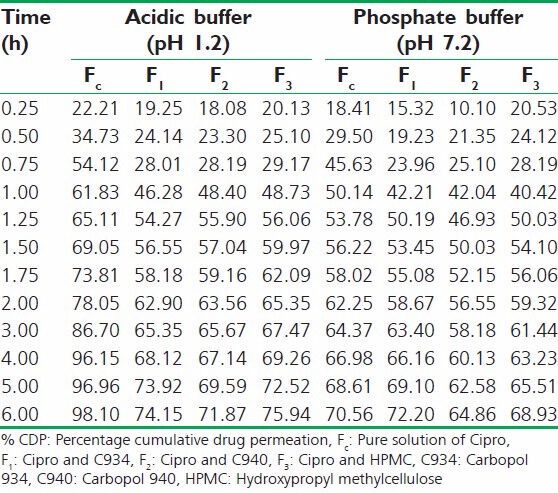
Table 2.
In vitro permeability profiles of the samples of Cipro through synthetic membrane up to 6 h
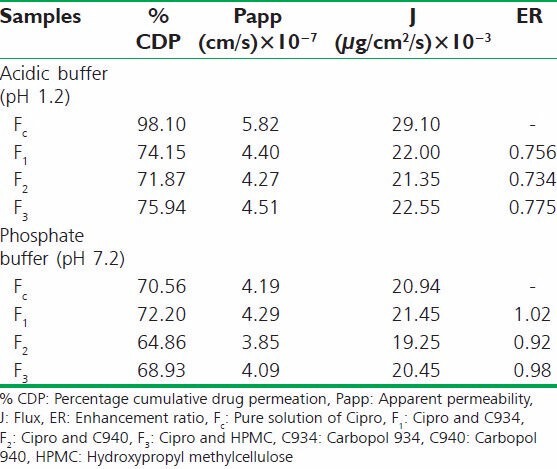
Figure 1.
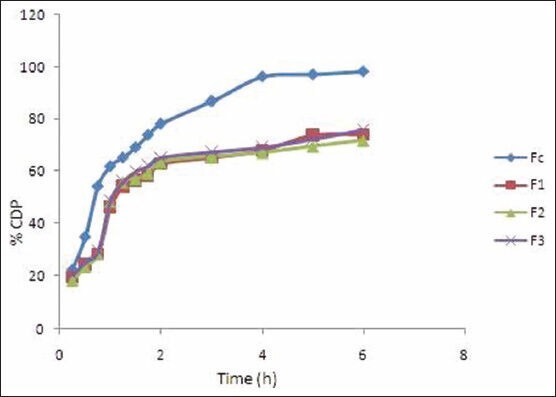
Comparative cumulative percentage drug permeation of different samples of Cipro versus time through synthetic membrane in acidic buffer up to 6 h
Figure 2.
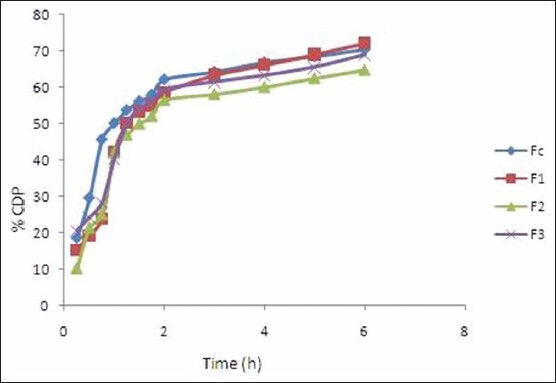
Comparative cumulative percentage drug permeation of different samples of Cipro versus time through synthetic membrane in phosphate buffer up to 6 h
Figure 3.
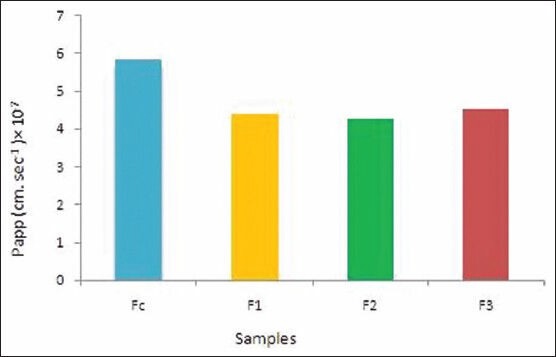
Comparative apparent permeability values of different samples of Cipro through synthetic membranes in acidic buffer up to 6 h
Figure 4.
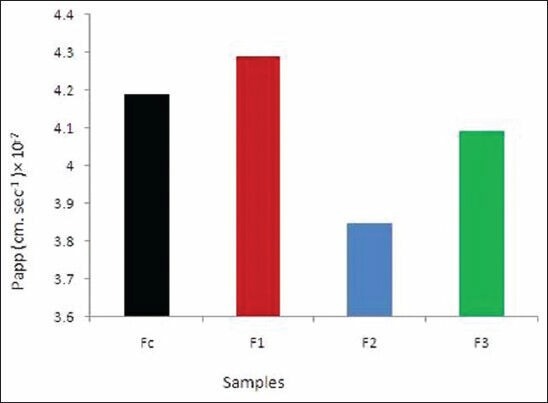
Comparative apparent permeability values of different samples of Cipro through synthetic membrane in phosphate buffer up to 6 h
The permeability study of the above-mentioned samples were also performed in a similar manner, using excised goat stomach mucosal membrane as diffusional membrane and acidic buffer at different time points up to 16 h. The results of this experiment have been mentioned in Table 3. The values of %CDP, Papp, and J were determined after 16 h in cases of all samples. These values were minimum in case of the formulation F2, while F1 showed maximum values. Moreover, by using excised goat intestinal mucosa as diffusional membrane in the presence of phosphate buffer, the formulation F2 also displayed minimum values, whereas they were maximum in case of F3 after 16 h. It was found that the Papp values of different formulations were more than the control when the goat intestinal membrane was used, while those values of these samples were less than the control in the presence of the goat stomach mucosal membrane [Tables 3 and 4]. Above-mentioned results have also been depicted in different graphs by taking %CDP at different time points versus time [Figures 5 and 6]. In addition, bar diagrams (by taking Papp of different samples) also indicate the permeability study results [Figures 7 and 8].
Table 3.
% CDP of Cipro from control and three suspensions of Cipro using biological membranes
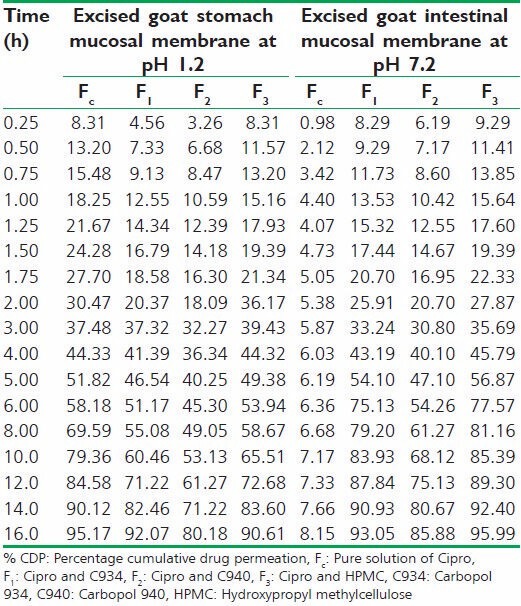
Table 4.
Ex vivo permeability profiles of the samples of Cipro through biological membranes up to 16 h
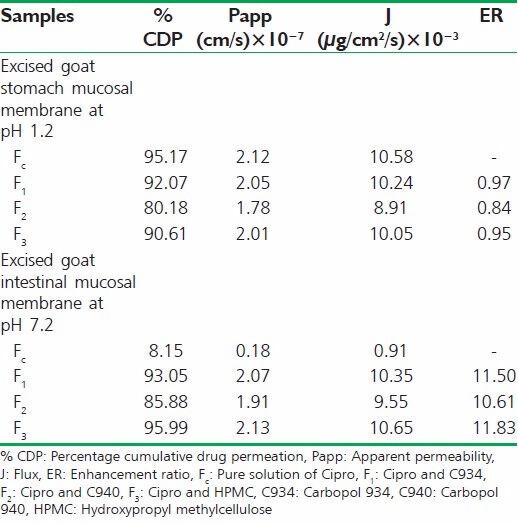
Figure 5.
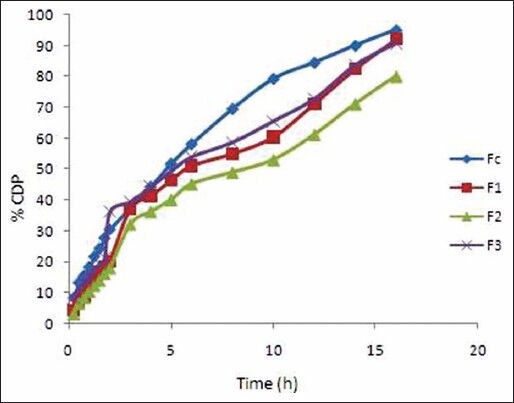
Comparative cumulative percentage drug permeation of different samples of Cipro versus time through excised goat stomach mucosal membrane in acidic buffer up to 16 h
Figure 6.
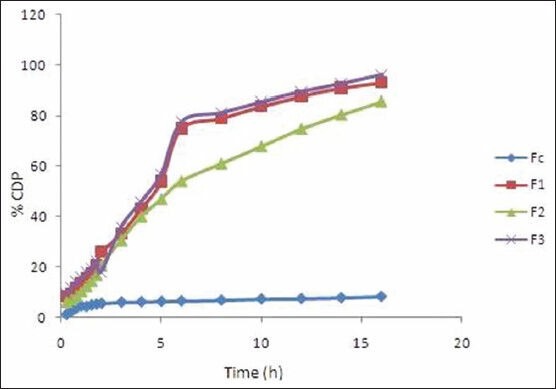
Comparative cumulative percentage drug permeation of different samples of Cipro versus time through excised goat intestinal mucosal membrane in phosphate buffer up to 16 h
Figure 7.
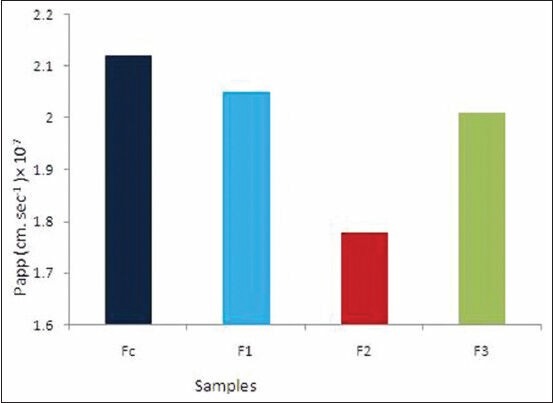
Comparative apparent permeability values of different samples of Cipro through excised goat stomach mucosal membrane in acidic buffer up to 16 h
Figure 8.
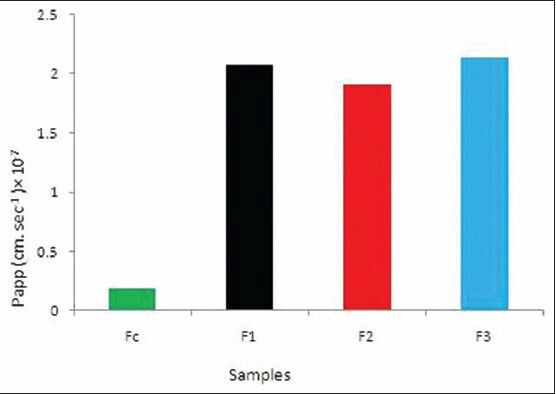
Comparative apparent permeability values of different samples of Cipro through excised goat intestinal mucosal membrane in phosphate buffer up to 16 h
The Papp value of F3 was found to be less as compared to F1 when the excised goat stomach mucosal membrane was used, whereas in the excised goat intestinal mucosal membrane, this value of F1 was less than that of F3. However, in both cases Papp value of F2 was minimum [Table 4]. For the evaluation of the effect of polymers on diffusion and permeation of Cipro, ER values of different formulations were calculated by separately taking both acidic and phosphate buffers, and different diffusional membranes. Their ER values were more in the intestinal mucosa, and the value was found to be the highest in case of F3 [Tables 3 and 4].
DISCUSSION
The drug permeation from Cipro containing formulations, such as F1, F2, and F3; was found to vary depending on their gelling properties and viscosity in acidic/alkaline environment in the presence of synthetic membrane. Among all formulations, the value of Papp was least in case of F2 considering all situations [Tables 2 and 4]. It suggests its both gelling property and viscosity seem to be maximum, but least mucoadhesive property may be observed in case of formulation containing C940 polymer.[15,16] Moreover, F3 showed lesser Papp value than F1 in excised goat stomach mucosal membrane, which might be due to its more gelling and less mucoadhesive properties in acidic pH. On the other hand, in excised goat intestinal mucosal membrane, Papp value of F1 was less than F3, which seems to be due to more pH sensitive in situ gelling, but less mucoadhesive properties of F1 [Tables 1, 4 and Figures 1, 8].[15] On the basis of overall results (using both synthetic/biological membranes), it might be mentioned that more controlled release action is expected from F3, whereas this action seems to be minimum in case of F2. These overcome the low absorption window of the drug at the intestinal part.
As mentioned earlier, from suspensions and aqueous solution of pure drugs, the extent of drug permeated up to 16 h was significantly different. The ER values of all suspensions showed higher permeation percent than aqueous solution of Cipro in the presence of the goat intestinal membrane. Moreover, the ER values of all formulations in the excised goat intestinal mucosal membrane were more than those in the presence of the goat stomach mucosal membrane [Table 4]. It indicates that the permeability of the drug was more enhanced by the polymers in the intestinal part, leading to more bioavailability and prolonged action in that region of the gastrointestinal tract.[15] In this manner, the limitation of BCS Class III drug (such as Cipro) could be overcome. In this connection, it may be mentioned that an electrostatic attraction force occurs between the negative charge of each formulation and positive charge of GI mucosal membrane. As a result, mucoadhesive property of the gel base might ensure an intimate contact between suspension and GI mucosal membrane, which seems to prolong the retention of the formulation at the site of absorption. This is beneficial for enhancing permeation.[17,18] That is why by taking into consideration of ER values of the present study, it may be mentioned that not only F3, but also other Cipro containing formulations are expected to show effective controlled release action.[19] Since HPMC is a long chained, nonionic polymer, its mucoadhesion is attributable to the formation of physical (including hydrogen) bonds with the mucus components. Moreover, it possesses a large number of hydroxyl groups that are responsible for bioadhesion. Its increased sites for bond formation may explain the increase in bioadhesion and enhanced permeability of the drug.[20] Probably due to these reasons, HPMC containing formulations might show very effective controlled release action.
CONCLUSION
Considering the overall results of this study, it may be concluded that HPMC containing formulation was the best suspension, which may show effective controlled release action. Even carbopol containing formulations might also produce controlled release action. In addition, it may be mentioned that the types of formulations used in this study would be interesting candidates (as all formulations are seemed to be effective) in the attempt to improve gastrointestinal drug absorption of ciprofloxacin and also to produce their controlled drug delivery. Since modeling, understanding, and characterizing the penetration and permeation process of drugs through various biological membrane barriers is essential in order to predict the in vivo behavior of formulation, this study is having tremendous importance. Relevant in vivo studies of the formulations should be carried out in the future to finally conclude their importance.
Footnotes
Source of Support: Nil
Conflict of Interest: Nil.
REFERENCES
- 1.Kyriacos SB, Boukarim C, Safi W, Mroueh M, Maroun AB, El-Khoury G, et al. In vitro testing of ciprofloxacin formulations and preliminary study on BCS biowaiver. J Food Drug Anal. 2009;17:78–84. [Google Scholar]
- 2.Chang DL, Jasmine EH, Pollock-Dove C, Patrick SL. (WO/2006/007354) A drug/polymer complex, preferably ciprofloxacin/HPMC, its method of manufacturing using lyophilisation and its use in an osmotic device. 2006. [Last cited on 2014 Jan 13]. Available from: http://www.wipo.int/pctdb/en/wo.jsp .
- 3.Khan MA, Shefeeq T. Role of mathematical modeling in controlled drug delivery. J Sci Res. 2009;1:539–50. [Google Scholar]
- 4.Henry DC, Jr, Bettis RB, Riffer E, Haverstock DC, Kowalsky SF, Manning K, et al. Comparison of once-daily extended-release ciprofloxacin and conventional twice-daily ciprofloxacin for the treatment of uncomplicated urinary tract infection in women. Clin Ther. 2002;24:2088–104. doi: 10.1016/s0149-2918(02)80099-6. [DOI] [PubMed] [Google Scholar]
- 5.Bettini R, Colombo P, Peppas NA. Solubility effects on drug transport through pH-sensitive, swelling-controlled release systems: Transport of theophylline and metoclopramide monohydrochloride. J Control Release. 1995;37:105–11. [Google Scholar]
- 6.Qiu Y, Park K. Environment-sensitive hydrogels for drug delivery. Adv Drug Deliv Rev. 2001;53:321–39. doi: 10.1016/s0169-409x(01)00203-4. [DOI] [PubMed] [Google Scholar]
- 7.Galaev IY, Mattiasson B. ‘Smart’ polymers and what they could do in biotechnology and medicine. Trends Biotechnol. 1999;17:335–40. doi: 10.1016/s0167-7799(99)01345-1. [DOI] [PubMed] [Google Scholar]
- 8.Jeong B, Gutowska A. Lessons from nature: Stimuli-responsive polymers and their biomedical applications. Trends Biotechnol. 2002;20:305–11. doi: 10.1016/s0167-7799(02)01962-5. [DOI] [PubMed] [Google Scholar]
- 9.Guo JH. Carbopol polymers for pharmaceutical drug delivery applications. Drug Deliv Technol. 2003:3. [Google Scholar]
- 10.Shoaib MH, Tazeen J, Merchant HA, Yousuf RI. Evaluation of drug release kinetics from ibuprofen matrix tablets using HPMC. Pak J Pharm Sci. 2006;19:119–24. [PubMed] [Google Scholar]
- 11.Singh N, Gupta P, Bhattacharyya A. Enhancement of intestinal absorption of poorly absorbed Ceftriaxone sodium by using mixed micelles of polyoxy ethylene (20) cetyl ether and oleic acid as peroral absorption enhancers. Arch Appl Sci Res. 2010;2:31–42. [Google Scholar]
- 12.Sahoo S, Chakraborti CK, Behera PK. In vitro antibacterial activities study of polymeric ciprofloxacin suspensions. Int Res J Pharm. 2012;3:302–4. [Google Scholar]
- 13.Haigh JM, Smith EW. The selection and use of natural and synthetic membranes for in vitro diffusion experiments. Eur J Pharm Sci. 1994;2:311–30. [Google Scholar]
- 14.Patel HJ, Patel JS, Desai BG, Patel KD. Permeability studies of antihypertensive drug amlodipine besilate for transdermal delivery. Asian J Pharm Clin Res. 2010;3:31–4. [Google Scholar]
- 15.Bregni C, Chiappetta D, Faiden N, Carlucci A, García R, Pasquali R. Release study of diclofenac from new carbomer gels. Pak J Pharm Sci. 2008;21:12–6. [PubMed] [Google Scholar]
- 16.Barakat NS. Evaluation of glycofurol-based gel as a new vehicle for topical application of naproxen. AAPS PharmSciTech. 2010;11:1138–46. doi: 10.1208/s12249-010-9485-x. [DOI] [PMC free article] [PubMed] [Google Scholar]
- 17.Hosny KM. Preparation and evaluation of thermosensitive liposomal hydrogel for enhanced transcorneal permeation of ofloxacin. AAPS PharmSciTech. 2009;10:1336–42. doi: 10.1208/s12249-009-9335-x. [DOI] [PMC free article] [PubMed] [Google Scholar]
- 18.Attia MA, El Badawy HY. Film forming gel for treatment of oral mucositis: In vitro studies. Int J Drug Deliv. 2010;2:314–21. [Google Scholar]
- 19.Shojaei AH. Buccal mucosa as a route for systemic drug delivery: A review. J Pharm Pharm Sci. 1998;1:15–30. [PubMed] [Google Scholar]
- 20.Akbari J, Saeedi M, Enayatifard R, Doost MS. Development and evaluation of mucoadhesive chlorhexidine tablet formulations. Trop J Pharm Res. 2010;9:321–27. [Google Scholar]


